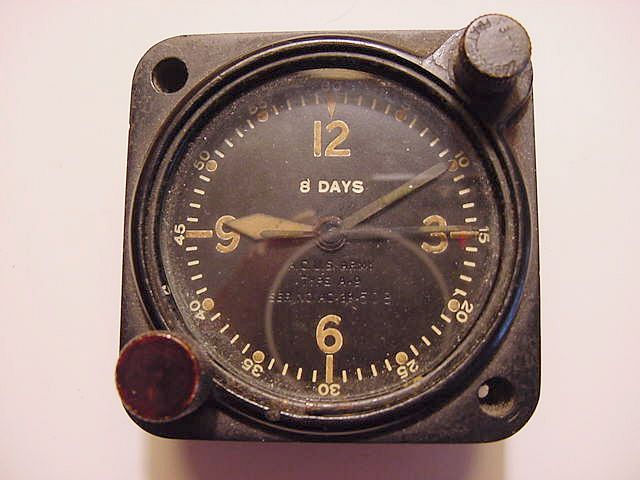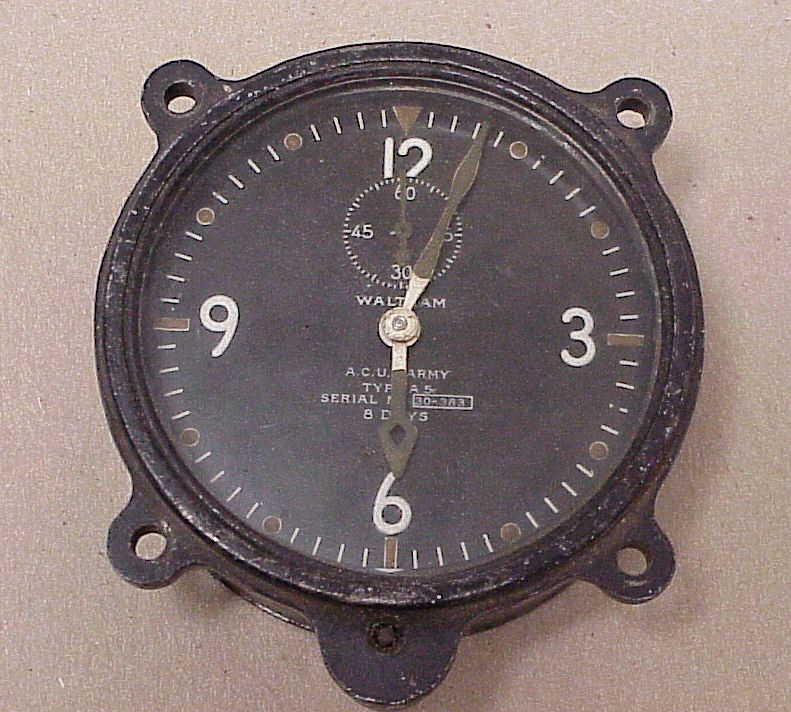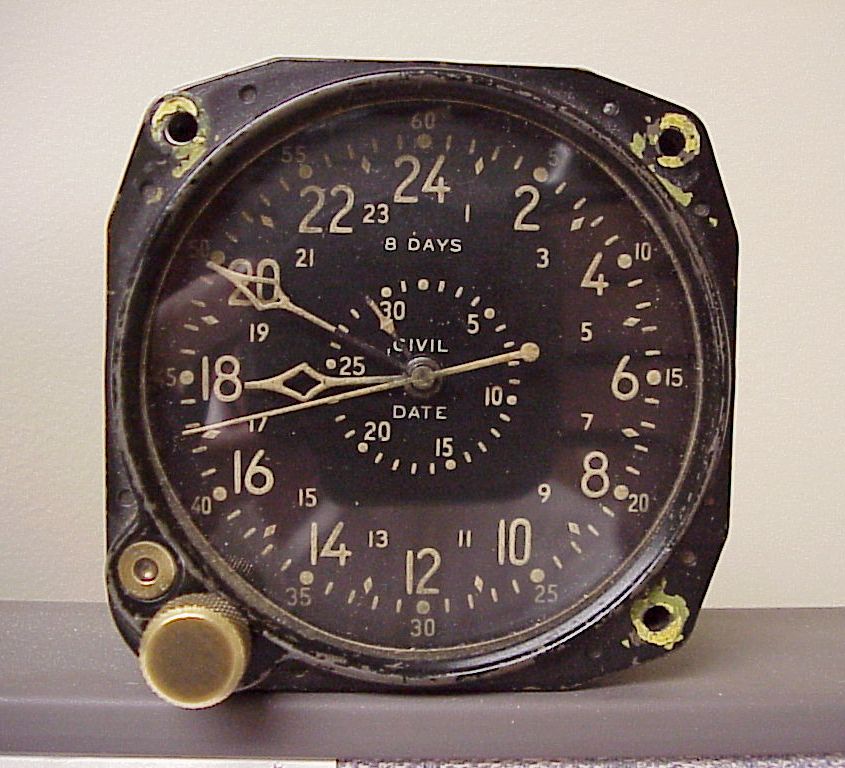
| WWT Shows | CLICK TO: Join and Support Internet Horology Club 185™ | IHC185™ Forums |

|
• Check Out Our... • • TWO Book Offer! • |
Welcome Aboard IHC185™  Internet Horology Club 185
Internet Horology Club 185  IHC185™ Discussion Site Main Page
IHC185™ Discussion Site Main Page  Horological Discussions, Questions and Answers
Horological Discussions, Questions and Answers  Military Timepiece Discussions - EXCLUSIVE!
Military Timepiece Discussions - EXCLUSIVE!  U.S. Aircraft Clocks
U.S. Aircraft Clocks
 Internet Horology Club 185
Internet Horology Club 185  IHC185™ Discussion Site Main Page
IHC185™ Discussion Site Main Page  Horological Discussions, Questions and Answers
Horological Discussions, Questions and Answers  Military Timepiece Discussions - EXCLUSIVE!
Military Timepiece Discussions - EXCLUSIVE!  U.S. Aircraft Clocks
U.S. Aircraft ClocksPage 1 2
Go  | New Topic  | Find-Or-Search  | Notify  | Tools  | Reply to Post  |  |
| Life Achievement Military Expert |
The - “A.S.S.C. U.S. Army" - on the dial of this clock stands for the Aviation Section of the Signal Corps. The ASSC was created in 1914, giving a definite status to the air service for the first time in the US Military. The air wing of the US Military was known as the A.S.S.C. until 1918, when the name was changed to the U.S. Army Air Corps. A few years after WWII, the U.S. Army Air Corps became the U.S. Air Force. Thus, this clock is from the dawn of American Military Aviation History. American Waltham Watch Co. in 1916, about a year before the USA entered W.W.I, or “The Great War“, as it was then known. Prior to 1917, the ASSC U.S. Army only had about 30 to 40 airplanes. More information regarding the early history of the U.S. Airforce is available on line at: quote: Best regards, Greg | ||
|
| Life Achievement Military Expert |
Here is the image....  | |||
|
Mine is marked A.S. for Air Service but is otherwise the same clock. The serial no. on mine is in the 1918 range. | ||||
|
| Life Achievement Military Expert |
Hi Donald, Thanks for the post. Is the dial of your clock marked, "A.S." above "U.S. Army"? Thanks, Greg | |||
|
Let me see if I have figured how to post a picture. If the picture doesn't attach, the A.S. is at the same location as your A.S.S.C. mark.  | ||||
|
Sorry about that, I keep it running and during the time my scanner took to warm up the minute hand ran over the S. Serial is 20907740. The hands are not original on mine but are from some other dark faced A.W. car clock. Mine came in a box of Pre-war and WWII radio head sets, mics. and tuners a friend gave me years ago and the hands were long gone. | ||||
|
| Life Achievement Military Expert |
Thank you for the picture Donald. You appear to have an early US Army Air Corps marked clock, issued shortly after the Air Service left the Signal Corps and became a seperate Corps or unit within the Army. | |||
|
| Life Achievement Military Expert |
The above two clocks are equipped with Waltham's Model XA 37 size, 8-day, 7 jewel movement. According to Marvin Whitney in his book MILITARY TIMEPIECES, the XA was subjected to higher level performance tests than the model XX. The XX being used in automobile and desk clocks. For comparison, in 1927 an XX cost $25.00 while the XA was priced at $36.50. This was the standard aircraft timepiece for the US Army Signal Corps, the US Army Air Corps and the US Navy Air Service. Per Whitney, the XA was also used by American Bell Telephone to regulate telephone switch boards. Non-military pilots also favored the Waltham Model XA. Lindbergh included one on the instrument panel of the Spirit of St. Louise for his famous trans-Atlantic flight to Paris. Best regards, Greg | |||
|
Thought I'd post a pic of my only aircraft clock. It is a Longines-Wittnauer, 7J, 8 day movement. The black writing just beneath the center post reads-- AC US Army Type A-9 SER. NO. AC-39-508 On the serial number the AC-39 is prestamped and the 508 appears to be later hand stamped. This clock winds and sets by the knob on the lower left. The knob on the upper right removes a small lightbulb. The label on the back states-- Order no. 39-4595-P Mfrs part no. 63-EAF Spec no. 27879 Longines-Wittnauer Watch Co, Inc Does anyone know specifically what type of aircraft used this clock? Also, the circle showing on the clock glass is a glare off of my camera. Tom  | ||||
|
| Life Achievement Military Expert |
An interesting clock. I'm not familure with the A-9 and I do not see any refferance to it in my small library. Except for the light, it is similar to the more common A-11 aircraft clock. Some Longines-Wittnauer aircraft clocks used LeCoultre movements, any idea what is in yours? It would be great to get some additional information about this model. It appears to be early WWII or maybe pre-WWII issue. At this time, I have not seen any resources for which air-clocks were used in which U.S. aircraft. Best regards, Greg | |||
|
Greg, I have not had the clock apart for over a year, but I believe that the movement said L-W on it. I think I would have picked up on it if it had said LeCoultre. Were the movements marked LeCoultre? When I get a chance, I'll dissamble it. Tom | ||||
|
| Life Achievement Military Expert |
Hi Tom, I have seen one in an A-11 AC clock. | |||
|
| Life Achievement Military Expert |
Another early Air Corps U.S.Army Waltham clock. Dial marking TYPE A-5. This is another one not mentioned by Whitney. Inside is the XA movement. The (missing) winding knob was made to stick out from the front rather than straight down as with the earlier U.S. aircraft clocks. The movement number would indicate an approximate date of 1927. The black painted light aloy case is marked ALUMAC NJ inside. On the outside of the back is a brass plate marked: "Order No.-4223-R Part No. 30-636 Waltham Watch Co."  | |||
|
Greg, I disassembled my A-9 clock. It is definitely a L-W 7J 8day movement. Tom | ||||
|
| Life Achievement Military Expert |
Thank you Tom. We now have a little more info on your A-9 clock. If the movement was made by Longines, I wonder if the serial number might give us an approximate date of manufacture? With my A-5, above, it's safe to assume a series of such cockpit clocks from A-1 through at least A-9. However, information regarding such things as date of acceptance and issue is lacking at this time. Best regards, Greg | |||
|
Hi Greg. I just came across this new internet chapter and the military timepieces forum. I wanted to thank you for putting it together as I have been looking for such a place to dicuss aircraft clocks for a long time - it seems there is very little information out there on these fascinating timekeepers. I have mostly questions to ask, but I have a bit of knowledge that I am happy to share as well. To begin with, I would like to amend your initial description of the names/structure of the U.S. aviation armed forces. The Aviation Section, Signal Corps did not become the Army Air Corps in 1918 - it became the Army Air Service. This in turn became the Army Air Corps in 1926. Here is a listing of the key dates of the evolution of the U.S. aviation armed forces (excluding the dates of some minor intermediary transitions): August 1, 1907 - Aeronautical Section of the Signal Corps. July 18, 1914 - Aviation Section (Signal Corps). May 24, 1918 - United States Army Air Service July 2, 1926 - United States Army Air Corps June 20, 1941 - United States Army Air Forces September 18, 1947 - United States Air Force To my mind, this list is perhaps one of the most helpful things to have around when trying to put a date on a U.S. aircraft clock. While it won't give you exact dates, it will place any U.S. aircraft clock with aviation branch of service markings on it within a bracket. That is assuming the clock has all original parts to it. And that is not an easy thing to assume since most aircraft clocks were repaired and rebuilt several times or more during their service life as is evidenced by various watchmakers marks and overhaul marks that one can find on these clocks. It is not hard to find an early Waltham movement made around 1915 or 1916 in a case with an A.S. (Air Service) dial instead of an A.S.S.C. dial which is evidence that either the dial was replaced on an early clock or the movement was replaced on a later clock. By the way, this same early Waltham aircraft clock can also be found with a "NAVY" marked dial - these are the hard ones to find as the Navy's aviation branch of the era was much smaller and had fewer planes. | ||||
|
| IHC President Life Member |
WELCOME ABOARD JIM! Thanks for your clarification on Air Force evolution and the very helpful Aircraft Clocks information. We're all pleased to have you with us and look forward to your continued participation. Lindell | |||
|
| Life Achievement Military Expert |
Thanks Jim. The above info is of considerable use. BTW, have you seen any Swiss made aircraft clocks used by the USA or USN in the pre-WWII era? It would appear that all of our aircraft used US made clocks. A related question concerns the timepieces in the British and French aircraft used by the AEF in Europe from 1917 through 1918. If the US kept the aircraft after the war, we may nave a few British and French issued timepieces which came back home with them. Best regards, Greg | |||
|
Nope, I can't say I've ever seen a Swiss made, WW I era, U.S. clock. The Walthams are the ones I've most often encountered, though I did once see a heavily corroded Chelsea with A.S.S.C markings so I know those must be out there somewhere as well. There could be other makers, but so far I've not run across them. I have seen guys with all kinds of car clocks - the kind you could buy as an aftermarket accessory back then - including Keyless Rimwinds and Phinney Walkers and many others that the guys were trying to sell as WW I era aircraft clocks. There is even a Phinney Walker model that has a picture of a biplane on the face. However, since none of these have any military markings and since I've not seen any period photos or catalogs showing these in aircraft I am not yet ready to accept they were actually intended for use in aircraft. Of course someone could have taken any aftermarket car clock or travel clock or even an ordinary pocket watch and screwed it onto an aircraft instrument panel for convenience back then, but that doesn't qualify as it being an aircraft clock in my mind anymore than if I screwed my wristwatch to my Toyota dashboard and called it a car clock. You raise a good point about the U.S. having a number of British and French aircraft in its wartime inventory. This was because the U.S. didn't have anything that could compare to what the British and French were building at that time and it would have been suicide to send a pilot up against something like a Fokker DVII in a crate like a Curtiss JN or R. Those were only good for training or behind the lines transports. The U.S. frontline squadrons used British and French aircraft. The U.S. also had some captured German aircraft as well, expecially after the war when the technology booty was being grabbed up by the allies to take home and reverse engineer to make their own aircraft better. As a result, I would expect there would have been a few German cockpit watches that came with the planes in the U.S. inventory for a while. Unlike the British and German penchant for watches, the French seemed to have gone with the American approach and used clocks in their aircraft. There are some French aircraft watches, but mostly you see clocks. The typical ones I've seen and the ones in my small collection seem to have have Swiss movements in French cases. I've found very little available information on these other than a blueprint of the case and dial specs from the French aviation ministry that appears to be what they provided to companies who wanted to produce and sell aircraft clocks to the ministry. Trying to figure out dates of manufacture for actual examples of the French clocks has driven me batty and I'm no closer today than when I started. For example, Doxa didn't mark their movements in that era with serial numbers, or the movements in most of the others don't have any maker's names on them other than a swiss cross and a serial number which does me no good without a maker's name. If there is anyone on this forum who is familiar with generic swiss makers of that era and how to date movements, or how to put a date on a Doxa movement with no serial number I would like to hear from them. | ||||
|
| Life Achievement Military Expert |
Hi Jim. Clearly, there are volumes to be written about aircraft clocks. I'm impressed with the scope of your research to date. Little is known, at least in English language texts, about French issued air-clocks of WWI, post-WWI, nor for that matter of WWII. Whitney has a picture of one in his book. It's a small clock in a leather case with straps. Whitney states that it was used in a WWI French observation baloon. My best source of information regarding Swiss watches is Pritchard's excellent two-volume set on Swiss WatchMakers. Now and then, such info as the date of registration of a Swiss brand name will assist in estimating the age of a military watch or cockpit clock. Best regards, Greg | |||
|
| Life Achievement Military Expert |
The Waltham, CIVIL DATE INDICATOR AERONAUTICAL (C.D.I.A.) clock The C.D.I.A. clock (CIVIL DATE INDICATOR AERONAUTICAL) is a well known and common WWII military timepiece. From Waltham factory records, Whitney has concluded that about 134,000 CDIA clocks were made in the course of 13 production runs from September, 1941 through October, of 1944. CDIA’s were used by the U.S. Army Air Force as well as in aircraft of the U.S. Navy. The heart of this 8 day, 15 jewel clock is a heavily modified Waltham 37 size car clock movement. Waltham originally introduced these movements around 1910. Over the years from 1910 until production stopped in 1944, this basic clock movement was used in a wide variety of civilian, military and industrial timepieces - from desk clocks to car clocks to guard clocks. In the CDIA, these movements have a center sweep second hand and a date function. However, they are otherwise non-hacking and do not have chronograph functions. There is some variation in the phosphorescent colors used for CDIA dial numerals. Some CDIA’s have alternative numbers and all of the date numbers set out in green with the rest in white. This makes a rather attractive and easy to use dial. Other examples of the CDIA , like the one pictured , have all of the numerals in white only. Information I do not have is a list of the aircraft which carried the CDIA. Another question is the extent to which any U.S. allies may have used these clocks as part of the Lend Lease program during WWII. Best regards, Greg  | |||
|
Interesting post! I was lucky and found a similar aircraft clock at the local flea market this past Saturday. Priced at 20 bucks, I was sure it probably wasn't working. I wound it up and it took right off! Has there been any more ideas on what type planes these were installed in? I presume the "U.S.anchor" mark in white paint is original? Thanks...Kim  | ||||
|
| Powered by Social Strata | Page 1 2 |
| Your request is being processed... |
|
©2002-2025 Internet Horology Club 185™ - Lindell V. Riddle President - All Rights Reserved Worldwide

